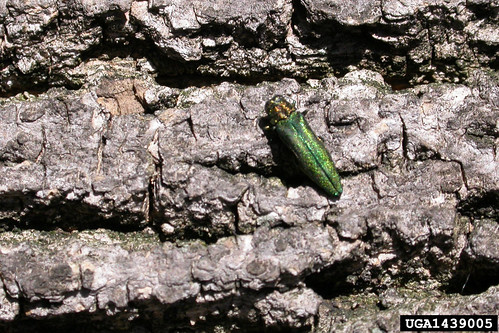April is the time to treat ash trees for killer beetle
By The Cooperative Extension Service
Fast Facts:
- April a good time to treat ash trees for Emerald Ash Borer
- Proper identification of tree, pest a key first step
- Cost of removing tree could be higher than cost to treat
- Professional help may be needed to treat affected trees
(580 words)
(Newsrooms: with file art at www.flickr.com/search/?text=Emerald%20ash%20borer&sort=relevance&user_id=32295574%40N05 )
LITTLE ROCK -- Homeowners who want to save their ashes need to treat those trees for emerald ash borer now through mid-April, say insect and tree experts for the University of Arkansas System Division of Agriculture.
The emerald ash borer, or EAB, is an invasive beetle from Asia that was first discovered in Michigan in 2002. Last July, it was confirmed in Clark, Columbia, Dallas, Hot Spring, Nevada and Ouachita counties in southwestern Arkansas.
“Homeowners in the infested area must now make a difficult choice: treat their ash trees with insecticide or let them succumb to attack and eventually pay for their removal,” said Tamara Walkingstick associate director of the Arkansas Forest Resource Center said. “Homeowners should understand that the cost of removing their trees can be much higher than the cost of treating their trees.”
Homeowners need to take a few first steps before treating their ash trees:
- Properly identify the tree as an ash tree. EAB in Arkansas has only been found in ash trees. So if it’s not an ash, then it’s not EAB damage. There are other native insects that can attack ash trees.
- Determine, to the extent possible, the overall condition of the tree. If the tree’s crown was thin last fall, then it might be too late to treat for EAB. This will be impossible to determine until the leaves appear however.
- The next step is to determine which treatment option might work best.
“There are several insecticide options available for those people who want to treat their trees. It is important to understand that controlling wood-boring insects with insecticides has always been a difficult proposition. This is especially true with EAB,” Walkingstick said, adding that treatment only should be done on affected trees or trees the owner wants saved.
Treatments may require professional help
John Hopkins, extension urban entomologist for the Division of Agriculture, and Walkingstick said that many of the more effective treatment options might require homeowners to hire professionals to treat their trees. Tree care professionals and arborists whom are certified pesticide applicators have access to more potent chemicals. Many of these chemicals must be injected into the trunk or the soil. Certain systemic bark sprays are also restricted use pesticides and can only be applied by someone certified by the state. Some of the chemicals are: dinotefuran, emamectin benzoate, azadirachtin, and imidacloprid.
The advantage of tree injections is that the treatment can last for two or three years.
Homeowners should ask about the tree care professional about their familiarity with and ability to use these treatments.
Homeowners can also try over-the-counter pesticides such as Bayer Advanced Tree and Shrub Insect Control and other systemic products on the market that are easy for homeowners to purchase and to use. Usually these are applied as a soil drench and should be applied from early to mid-spring.
Homeowners should look for the words “Tree and Shrub” on the label and imidacloprid as the active ingredient. Before purchasing or using any pesticide, always read and carefully follow the label directions.
“Do not apply more with the idea that if a little will work, a lot should work better,” Hopkins said.
Know the signs
Signs and symptoms of EAB infestation include heavy woodpecker feeding, thinning tree crown, D-shaped exit holes, and S-shaped feeding galleries beneath the bark.
Residents also need to remember that a quarantine on the movement of all hardwood firewood to areas outside of the quarantine remains in effect for the following counties. Twenty-five counties are included in the quarantine.
For more information about the emerald ash borer, visit us at www.uaex.uada.edu. More information can be found at www.emeraldashborer.info or www.arinvasives.org. A fact sheet about the borer may be found at: “Emerald Ash Borer: A pest of ash trees in Arkansas,” downloadable at www.uaex.uada.edu/publications/pdf/FSA-7066.pdf.
Product mention in this news story do not imply endorsement by the University of Arkansas System Division of Agriculture.
Pursuant to 7 CFR § 15.3, the University of Arkansas System Division of Agriculture offers all its Extension and Research programs and services (including employment) without regard to race, color, sex, national origin, religion, age, disability, marital or veteran status, genetic information, sexual preference, pregnancy or any other legally protected status, and is an equal opportunity institution.
# # #
Media Contact: Mary Hightower
Dir. of Communication Services
U of A Division of Agriculture
Cooperative Extension Service
(501) 671-2126
mhightower@uada.edu
Related Links
